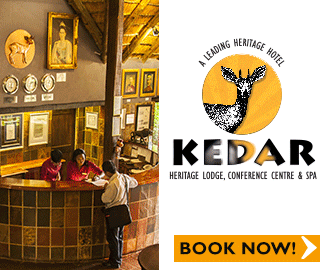
Namibia: Land Of Beauty And Splendour
BY JO KROMBERG 12TH JAN, 2015 07:15
Five ‘o clock in the morning has never been my finest hour. Thus I find myself going through sleepwalking motions as the lovely lady from Air Namibia welcomes me aboard with a beaming smile en route to Walvis Bay in Namibia from Johannesburg, South Africa.
Eventually we see nothing but massive silent sand tsunamis all around us. The breeze shifts the sand almost imperceptibly, but just enough to confuse your depth perception completely."
"
The next day we tackle the long drive inland to Damaraland, with a detour to Twyfelfontein to have a look at the bushman paintings. We lunch at Twyfelfontein Country Lodge – a bush lodge in the middle of nowhere with the most breathtakingly phenomenal setting within massive boulders.
We overnight at the Mopane Gondwana Lodge. Built in the wattle and daub style under Mopane trees and connected by a labyrinth of paths, the main building and chalets of the lodge look like an African village. Each of the 60 double room chalets sits in a vegetable and herb garden. The accommodation is a bare affair – don’t expect luxury or extras.
A visit to the area’s Himba tribe is our first stop the next day at Gelbingen Lodge, situated in a mountainous valley in the middle of a Mopani tree savannah in Damaraland. They are a truly beautiful and serene people and their prolific photographs in magazines and galleries all over the world are testament to just how synonymous they are with Namibia. We arrive at Etosha Safari Lodge just in time for a late lunch. Willie goes exploring with the camera while I literally pass out in my beautiful chalet from total exhaustion because of our rapid itinerary pace and distances travelled the past few days. Accommodation at Etosha Safari Lodge is in 60 single or double chalets, including five family rooms. Each unit is equipped with an en-suite bathroom, fan, mosquito nets, a tea/coffee station and a private veranda, with great views of the surrounding environment.
After a lovely buffet dinner I drift off to sleep to the soothing sounds of the African night and a million brilliant stars shining down. The next morning the rest of the group go on a full-day game drive through the Etosha National Park while I decide to catch up on some work and explore the lodge with its magnificent view over the African bush. The main building at Etosha Safari Lodge houses a restaurant, a bar and a guest lounge and there are three swimming pools. I grab my laptop after lunch and perch on a sun bed alongside the bottom pool with an uninterrupted view of the African plains – sheer heaven.
The evening improves dramatically as we are treated to song and dance by a duo called The Safari Boys during a lovely buffet dinner at Etosha’s neighbouring Gondwana camp, also ideal for families with both chalet and camping accommodation options.
Erindi Private Game Reserve awaits us the next day after an exhausting four-hour drive. Midway between Windhoek and Otjiwarongo, in the Omaruru District in Namibia, Erindi is in a breath-taking 79 000-hectare, malaria-free conservation area amidst grasslands, mountains and volcanic rock. It is also home to more than 15 000 head of game and over 300 bird species. Translated as ‘a place of water’, Erindi is also a pioneer in conservation programmes and eco-management models. The delectable buffet lunch offered a number of mouth-watering options and is worthy of any 5-star lodge.
Instead of going on the game drive, we spend the afternoon on the deck, sampling the numerous types of cake and pastry goodies served with high tea whilst overlooking the bush and watering hole. We are privileged to experience an once-in-a-lifetime sight as we watch a pack of wild dogs chasing a crocodile into the water as an elephant trumpets at them – all right in front of us!
Pathways wind their way through the camp to reveal luxury suites tucked between indigenous trees and soft green lawns. The spacious family units have two separate rooms with an inter-leading door, a sprawling veranda with a view of the smaller watering hole and are situated next to the swimming pool. We spot various game species from our suite patio that evening after dinner, including, rhino, giraffes, springbuck and zebras.
We leave Namibia the next day with heavy hearts – this country with its amazing contrasts, magnificent landscape and barren beauty has made a profound impression on me and will remain with me forever.
Swakopmund Town, Namibia: The town has a population of 45 000 and its water supply relies on boreholes. Photo: Smith

Bushmen carvings in Damaraland, Namibia. Photo: Wallie Smith

Desert Dunes in Namibia: The desert is 90 per cent quartz mineral. Photo: africanportfolio.com

The country of vast, barren nothingness stretches to infinity beneath the plane from Windhoek, the capital of Namibia, to Walvis Bay, situated 310 kilometres away. The dusty road snakes through the countryside like an ochre artery from 25 000 feet and the vast desert looks like the dry, cracking skin of a very old man.
The mist is rolling in at Walvis Bay, making for a petrifying instrument landing. Africa is not for sissies. We step off the plane to a freezing 12oC compared to Windhoek’s almost 20 - the contrasts in Namibia are extreme.
Our first location is Beach Lodge in the bustling metropolis of Swakopmund, about half an hour’s drive from Walvis Bay through the barren desert. The hotel is literally on the shoreline and the sea breeze coolly caresses the quaint nooks and crannies of this uniquely designed hotel.
It is the only hotel in Swakop directly on the beach. Each room has a magnificent view of the sea and the hotel is situated about 5km from the town centre. The location, architecture, ambience and service are impressive and very good value for money.
There are 11 twin rooms and four family rooms with two single beds in the second bedroom, separate bathroom with bath and shower. All rooms are equipped with telephone, satellite TV, a coffee/tea station and a small fridge. Augustinus, our delightful driver and tour guide gives us a quick tour of Swakopmund. One clearly sees the German influence and culture. The town has a population of 45 000 and its water supply relies on boreholes. Augustinus pronounces Germans as "Yemens". The ‘Yemens’ may be good at many things, but in my opinion architecture is not one of them, although the town has a certain barren, windswept charm about it.
The charming Italian owner and chef treats us to a feast of a taster menu with the best ravioli, mussels, lasagne and prawns I have ever had in my life. The restaurant is situated within a functioning lighthouse and kiddies’ portions are available.
“Welcome to civilisation!” So greets maverick Tommy, later as we head to the desert dunes to experience ‘Tommy’s Living Desert Tour’. As we slowly meander over the yellow dunes in our deflated tyres, he educates us about the fragility of the environment. He is unbelievably knowledgeable and the kids on the tour with us are enthralled as he describes the water manufacturing habits of desert worms and puts a legless lizard into his mouth to the horrified delight of the kids. The dunes resemble soft, flowing caramel velvet as we continue on. The desert is 90 per cent quartz mineral, which gives it its colour, says Tommy.
The dunes play tricks on our eyes the further we go. Eventually we see nothing but massive silent sand tsunamis all around us. The breeze shifts the sand almost imperceptibly, but just enough to confuse your depth perception completely.
He also shows us a fascinating sidewinder snake – its camouflage is perfect. On the way back all we can see is sand and the vast nothingness goes on and on and on in this terrifyingly beautiful moonscape of emptiness. Words cannot convey the simultaneous feeling of helplessness, yet serenity, of being totally surrounded by these silent, undulating masses of sand with its teeming underworld of life. Back at the hotel a quick shower and then we traverse what feels like a mile-long walkway out into the open sea at a restaurant called The Pier. The food, the service, the location with the waves crashing beneath us, as well as the ambience is all unsurpassable.
Day two is a whole different kettle of fish literally. After breakfast we depart for a hosted seal and dolphin cruise on Catamaran Cruises, which takes us through the port of Walvis Bay, Bird Island, past fish trawlers and on to Pelican Point. Fresh oysters and champagne are served between whale spotting and the seals that swim up and join us for something to eat.
We play in the dunes again in the afternoon and this time our guide is Casper who shows us how real fun in a 4x4 can be had as we scale and descend the dunes with whoops and shrieks of pure adrenalin. We have a superb dinner at the hotel’s resident restaurant, The Wreck, and all fall into bed early, completely exhausted.














